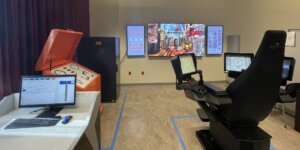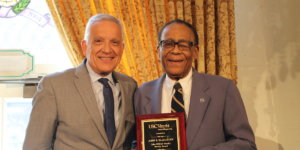
Offshore oil refinery in Thailand Photo/iStock
Big Data has become the oil of the new digital economy. So it’s not surprising that energy companies, which rely on complex equipment for drilling and oil well maintenance, are in pole position to benefit from automation fueled by advances in big data and machine learning.
According to a recent marketing report published by Credence Research, the Global Big Data Services Market for the Oil and Gas Industry is expected to reach $33.5 billion by 2023. A typical modern offshore oilfield has over 10,000 sensors pumping peta bytes of data per day forming deeply intertwined cyber-physical systems that rely increasingly on algorithms and robotics. As sensor technology becomes cheaper and wireless, there is a premium on the ability to extract and manage large volumes of data in real time. Enter artificial intelligence.
In 2003, Donald Paul, then Chevron’s Chief Technology Officer saw this coming. He, and C.L. Max Nikias, then USC Viterbi Dean, envisioned a paradigm in the world of engineering — CiSOFT— the Center for Interactive Smart Oilfield Technologies, a joint venture between USC and Chevron. Now headed to its 15-year-anniversary, the partnership has redefined the relationship between academic and industrial research.
“As we were expanding sensor technology at Chevron, the Internet of Things (IoT) model was a trend that wasn’t really accounted for,” Paul said. “We needed another structure and another model. One that could produce hybrid engineers who live at the intersection of petroleum engineering and information technology.”
With a number of interdisciplinary teams of researchers from USC and Chevron, respectively, the center soon became the embodiment of Engineering + X, where the X is geosciences. Paul later joined the ranks of USC Viterbi faculty, becoming Executive Director of the Energy Institute. Meanwhile, CiSOFT continued to expand its research under the leadership of Dean Yannis Yortsos and Professor and Director of Petroleum Engineering, Iraj Ershaghi, the center’s current director.
Converging Disciplines
CiSOFT hosts some of the first large-scale collaborations between electrical engineering and computer science to tackle complex issues like production efficiency, safety, environmental impact, data integration and automation.
“I love a project where we solve a problem and in doing so, we create the technical basis to expand to other problems.”
-Donald Paul
It has attracted key figures in interdisciplinary research, such as Director of Center of Energy Informatics (CEI) and Professor of Electrical Engineering and Computer Science, Viktor Prasanna, a globally recognized expert in high performance computing. Prasanna is developing a fundamental way of representing networks of very large cyber-physical systems like oil fields and power grids.
“The key driving factor of this research is data science,” said Prasanna. “You can gather these large amounts of data, but can you understand that data?”
Prasanna and his CiSOFT collaborators worked to develop a networked system that went through data pulled from the oil rigs, coupled with weather, historical archives, market conditions, and even tweets.
“If you’re going to institute things like machine learning you need history,” said Paul who explained that the petroleum industry often collects data that can never be collected again. “You drill a well and that location, those measurements that are cut through virgin rock can’t be duplicated.”
Few modern industries can boast historical data that goes back to the turn of the 20th century.
Using sophisticated machine learning techniques, historical and real-time data integration and automation, Prasanna’s team has given petroleum engineers and the machines they operate the ability to respond immediately to problems as they arise. Solutions like this become imperative when minute adjustments can mean preventing disastrous field accidents — especially in highly sensitive operations such as underwater or coastal environments.
“It is a process of closing the loop. We take the data, make some sense out of it, make some decisions, then we go back and control the operational system. ” Prasanna said. “The goal is to ultimately get the computers in ‘the loop’ as much as possible.”
In the future, Prasanna wants machines to not only collect and process data but also to start making some of the decisions.
The beauty of these technologies for USC Viterbi faculty and students working on these projects is their elastic utility.
“It has a way to adapt automatically and it scales,” Paul said. “It was developed for oil and gas but has rolled over successfully to power grids.”
Smart oilfield research at CiSOFT will eventually spill into the rapidly approaching age of the Internet of Things (IoT), when electronic devices will communicate with each other across an internal network for a variety of industries and even home solutions.
The need for the integrated data solutions proposed by Prasanna may become invaluable for a variety of applications where real time data processing is needed, from smart cars to open heart surgery.
Hybrid Engineers
At CiSOFT, researchers and students get face-to-face interaction with engineers on the front lines at Chevron. Some students are even recruited by the company upon graduation. Similarly, Chevron sends specialists to teach at USC and Chevron employees take specialized courses together with USC Viterbi students.
The training students receive is not only meant to turn them into high-caliber petroleum engineers, but also to create the next generation of hybrid engineers looking to automate complex processes in a variety of industries.
“I love a project where we solve a problem and in doing so, we create the technical basis to expand to other problems,” said Paul who is now looking forward to CiSOFT Second Generation focused on machine intelligence.
“The phenomenal thing about CiSOFT is that we’re training of new generations of students how to automate complex process industries,” said USC Viterbi Dean Yannis C. Yortsos. “This training goes deeper than oil and can be used in a variety of applications.”
It is a mix of industry and academia that, according to Ershaghi, works symbiotically:
“Chevron is interested to see that no matter how much technology develops, education goes hand in hand.”
Moreover, the science that comes out of the center benefits the science and engineering community at large. Data mining methodologies as well as software and hardware innovations, once patented, are published.
Many of these are currently working their way to the commercial market through other industry partners at CiSOFT.
“We’ve graduated more than one hundred Ph.D,’s from the center,” Ershaghi said. “Not all of them ended up working in the oil industry. Many go to work for internet giants such as Facebook which also use multifaceted applications that involve Big Data.”
Published on September 14th, 2017
Last updated on September 17th, 2017














